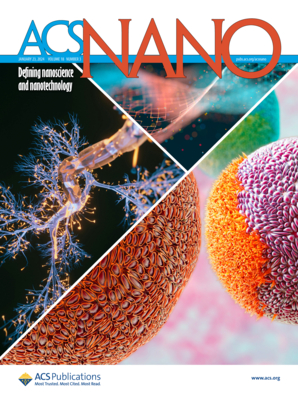Ultrasmall PtIr Bimetallic Nanozyme Treats Myocardial Infarction via Ischemic/Inflammatory Cardiac Microenvironment Remodeling
IF 15.8
1区 材料科学
Q1 CHEMISTRY, MULTIDISCIPLINARY
引用次数: 0
Abstract
Myocardial infarction (MI) poses a serious threat to human health. MI induces oxidative damage and inflammation, leading to myocardial death, scarring, and ventricular remodeling. Nanozymes have shown potential to alleviate reactive oxygen species (ROS)-induced damage and treat cardiovascular diseases. In this study, we developed an ultrasmall PtIr bimetallic nanozyme to treat MI. The PtIr nanozyme exhibited robust superoxide dismutase- and catalase-mimicking catalytic activities, modulating the conversion of excessive ROS into harmless products. Furthermore, PtIr nanozyme treatment reduced ROS levels and apoptosis in human cardiomyocyte AC16 cells under oxidative stress in vitro, while increasing the expression of cardiomyocyte-related functional genes, including cTnT, cTnI, Cx43, and ACTN2. It also maintained the intracellular mitochondrial membrane potential, increased mitochondrial activity, and protected mitochondrial structure. In a rat MI model, the PtIr nanozyme attenuated neutrophil extracellular trap formation, apoptosis, and inflammation in the infarcted heart 1 week postadministration. Four weeks postadministration, the PtIr nanozyme significantly enhanced cardiomyocyte activity and functional connectivity, reduced infarct size and fibrosis levels, and increased microvascular density compared with phosphate-buffered saline or Ir nanozyme treatment. Proteomic analysis revealed that proteins associated with energy metabolism, mitochondrial function, and myocardial contraction were upregulated, while multiple pathways related to mitochondrial function and energy metabolism, such as fatty acid β-oxidation and the citric acid cycle, were enriched in the PtIr nanozyme injection group. These results suggest that the PtIr nanozyme remodels the infarct microenvironment by modulating mitochondrial function and the inflammatory response, repairing the damaged myocardium, and improving cardiac function. Our findings highlight a promising therapeutic strategy for MI.

求助全文
约1分钟内获得全文
求助全文
来源期刊

ACS Nano
工程技术-材料科学:综合
CiteScore
26.00
自引率
4.10%
发文量
1627
审稿时长
1.7 months
期刊介绍:
ACS Nano, published monthly, serves as an international forum for comprehensive articles on nanoscience and nanotechnology research at the intersections of chemistry, biology, materials science, physics, and engineering. The journal fosters communication among scientists in these communities, facilitating collaboration, new research opportunities, and advancements through discoveries. ACS Nano covers synthesis, assembly, characterization, theory, and simulation of nanostructures, nanobiotechnology, nanofabrication, methods and tools for nanoscience and nanotechnology, and self- and directed-assembly. Alongside original research articles, it offers thorough reviews, perspectives on cutting-edge research, and discussions envisioning the future of nanoscience and nanotechnology.
 求助内容:
求助内容: 应助结果提醒方式:
应助结果提醒方式:


